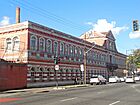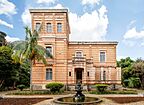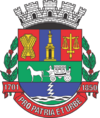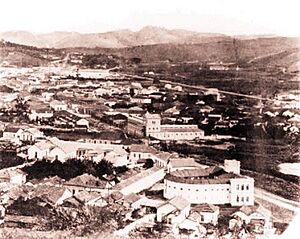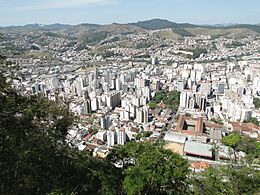Juiz de Fora facts for kids
Quick facts for kids
Juiz de Fora
|
|||
|---|---|---|---|
|
Municipality
|
|||
| Municipality of Juiz de Fora | |||
|
|
|||
|
|||
| Nickname(s):
JF
|
|||
| Motto(s):
Pro Patria et Urbe "For the homeland and the city"
|
|||
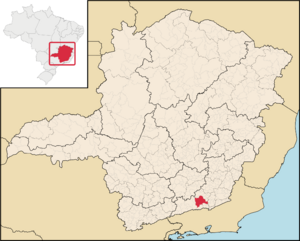 |
|||
| Country | |||
| Region | Southeast | ||
| State | |||
| Incorporated | 30 May 1850 | ||
| Area | |||
| • Total | 1,436 km2 (554 sq mi) | ||
| Elevation | 678 m (2,224 ft) | ||
| Population
(2022)
|
|||
| • Total | 540,756 | ||
| • Density | 376.64/km2 (975.5/sq mi) | ||
| Time zone | UTC-3 (UTC-3) | ||
| • Summer (DST) | UTC-2 (UTC-2) | ||
| Postal Code |
36000-000
|
||
| Area code(s) | +55 32 | ||
| HDI (2010) | 0.778 – high | ||
Juiz de Fora (pronounced Jweez jee FOH-rah), often called J.F., is a lively city in the southeastern part of Minas Gerais, a state in Brazil. Its name means "Outsider Judge," which is quite unique!
The city is home to over 540,000 people, according to the 2022 census. It covers an area of about 1,437 square kilometers. Juiz de Fora is located strategically. It sits between three of Brazil's most important cities: Rio de Janeiro (about 189 km away), Belo Horizonte (about 260 km away), and São Paulo (about 486 km away). This location has been key to its growth. Major roads, like the BR 040, connect Juiz de Fora to these big cities. The city is built along the Paraibuna River.
Contents
- History of Juiz de Fora: From Gold Rush to Modern City
- Geography of Juiz de Fora: Location and Climate
- Economy: Industries and Trade in Juiz de Fora
- Transport: Getting Around Juiz de Fora
- Culture: A Rich and Diverse City
- Sport: Football and Volleyball in Juiz de Fora
- Demography: Who Lives in Juiz de Fora?
- Notable People from Juiz de Fora
- See also
History of Juiz de Fora: From Gold Rush to Modern City
The story of Juiz de Fora began in the early 1700s. Back then, a new road called the Caminho Novo (New Way) was opened. This road connected Rio de Janeiro to the gold mining areas of Minas Gerais. The region around Juiz de Fora was covered in thick forests, which is why it was called "Zona da Mata" (Forest Zone).
At first, only a few people lived here. They were mostly merchants and farmers. They helped travelers who were on the long journey between the coast and the gold mines.
How Coffee and Industry Shaped the City
After the gold mines started to decline, people looked for new ways to invest their money. They started planting coffee. The Zona da Mata region became perfect for coffee farms. The small village, then called Santo Antônio do Paraibuna, was in a great spot. It had a good road connection to the country's capital and its port.
In 1850, the village officially became a city. Progress continued in 1861 with the completion of the Estrada União e Indústria (Union and Industry Road). This was the first paved road in Latin America! Its name showed the city's new focus: industry was becoming more important than coffee farming.
Just five years later, a new railway reached the city. Then, in 1889, something truly amazing happened. The first hydroelectric power plant in Latin America, called Marmelos Zero, was built near the city. It used the Paraibuna River to create electricity.
Growth and Challenges in the 20th Century
With new money from both Brazil and other countries, Juiz de Fora's industries grew fast. The city became a major center and the largest urban area in the state. By the early 1900s, Juiz de Fora was one of the top textile and industrial producers in South America. It was almost as wealthy as big cities like São Paulo and Rio de Janeiro.
However, things changed. The coffee farming frontier moved to São Paulo, which became very rich. Also, a lot of the wealth from Minas Gerais was used to build a new state capital, Belo Horizonte. This meant Juiz de Fora lost some of its importance. The Great Depression in the 1930s made things even harder for the city. By the 1940s, Juiz de Fora was not as influential as it once was.
A New Beginning: Rebirth and Modern Growth
The city's population didn't grow much from the 1930s to the 1960s. But in the mid-1970s, Juiz de Fora started to grow again. This new era began when a federal university (UFJF) was built in the city. The Brazilian government also decided to make Juiz de Fora a major military center.
This led to a new industrial boom. The city started focusing on heavy industries like steel and engineering. More recently, Juiz de Fora is growing again. It's becoming an important center for services like telecommunications and education. Many private colleges have opened, making it a popular place for students.
Today, Juiz de Fora is a key commercial hub for the area around it. It's the center of a large unofficial metropolitan area with over 1 million people.
Geography of Juiz de Fora: Location and Climate
Juiz de Fora is located in the southeast of the Minas Gerais state. It is considered the main city in the Intermediate Geographic Region of Juiz de Fora.
Strategic Location and Distances
The city's location is very important. It's close to major cities like Rio de Janeiro, Belo Horizonte, and São Paulo. It's also on the main road that connects Rio de Janeiro to Belo Horizonte and even Brasília, Brazil's capital.
Here are the distances from Juiz de Fora to some important cities:
- Rio de Janeiro: 184 km
- Belo Horizonte: 272 km
- São Paulo: 506 km
- Vitória: 519 km
- Brasília: 992 km
Understanding Juiz de Fora's Climate
Even though Juiz de Fora is in a tropical area, its climate is quite mild. This is because the city is located at a high altitude, between 700 and 900 meters above sea level. This makes the weather cooler and rainier than in lower areas nearby.
Juiz de Fora has a humid subtropical climate. This means it has two main seasons:
- Hot and Rainy Season: From October to April.
- Cooler and Drier Season: From May to September.
The average temperature throughout the year is around 19°C. The average high is about 24°C, and the average low is around 15°C. The city is very humid, with an average humidity of 80%. It also gets a good amount of rain, usually between 1300 and 1500 mm per year.
| Climate data for Juiz de Fora (1991–2020) | |||||||||||||
|---|---|---|---|---|---|---|---|---|---|---|---|---|---|
| Month | Jan | Feb | Mar | Apr | May | Jun | Jul | Aug | Sep | Oct | Nov | Dec | Year |
| Mean daily maximum °C (°F) | 27.3 (81.1) |
28.0 (82.4) |
26.9 (80.4) |
25.4 (77.7) |
22.7 (72.9) |
22.2 (72.0) |
22.3 (72.1) |
23.3 (73.9) |
24.4 (75.9) |
25.4 (77.7) |
25.3 (77.5) |
26.7 (80.1) |
25.0 (77.0) |
| Daily mean °C (°F) | 21.8 (71.2) |
22.1 (71.8) |
21.3 (70.3) |
20.0 (68.0) |
17.6 (63.7) |
16.9 (62.4) |
16.7 (62.1) |
17.3 (63.1) |
18.5 (65.3) |
19.6 (67.3) |
19.9 (67.8) |
21.2 (70.2) |
19.4 (66.9) |
| Mean daily minimum °C (°F) | 18.1 (64.6) |
18.2 (64.8) |
17.7 (63.9) |
16.4 (61.5) |
14.1 (57.4) |
13.2 (55.8) |
12.8 (55.0) |
13.1 (55.6) |
14.3 (57.7) |
15.5 (59.9) |
16.2 (61.2) |
17.5 (63.5) |
15.6 (60.1) |
| Average precipitation mm (inches) | 297.4 (11.71) |
170.3 (6.70) |
207.5 (8.17) |
78.5 (3.09) |
38.6 (1.52) |
17.3 (0.68) |
14.4 (0.57) |
18.8 (0.74) |
57.8 (2.28) |
117.6 (4.63) |
236.2 (9.30) |
310.4 (12.22) |
1,564.8 (61.61) |
| Average precipitation days (≥ 1.0 mm) | 15.8 | 11.0 | 13.1 | 6.8 | 4.6 | 2.9 | 2.5 | 3.0 | 5.9 | 9.9 | 14.9 | 17.0 | 107.4 |
| Average relative humidity (%) | 81.4 | 79.1 | 82.2 | 81.9 | 81.8 | 80.6 | 77.6 | 73.8 | 74.3 | 77.5 | 83.3 | 82.9 | 79.7 |
| Average dew point °C (°F) | 18.9 (66.0) |
18.9 (66.0) |
18.7 (65.7) |
17.3 (63.1) |
15.0 (59.0) |
14.0 (57.2) |
13.1 (55.6) |
13.0 (55.4) |
14.3 (57.7) |
16.0 (60.8) |
17.4 (63.3) |
18.6 (65.5) |
16.3 (61.3) |
| Mean monthly sunshine hours | 150.7 | 162.2 | 146.9 | 154.8 | 160.2 | 166.1 | 184.5 | 182.5 | 145.3 | 136.7 | 118.0 | 142.8 | 1,850.7 |
| Source: NOAA | |||||||||||||
Economy: Industries and Trade in Juiz de Fora
Juiz de Fora is a very important industrial center in Minas Gerais. It's the third largest industrial hub in the state. The city has major steel mills and car factories, including the famous Mercedes-Benz. There are also many textile factories.
Beyond industry, Juiz de Fora is a big trade center. It serves as the main city for the surrounding Zona da Mata region. You can find four large shopping malls, many hypermarkets, and countless smaller shops here. This makes it a great place for shopping and business.
Transport: Getting Around Juiz de Fora
Juiz de Fora has good transport connections, making it easy to travel to and from the city.
Main Roads Connecting Juiz de Fora
- BR-040: This important highway links Juiz de Fora to cities in Minas Gerais and Rio de Janeiro. It connects places like Belo Horizonte, Barbacena, Rio de Janeiro, and even Brasília.
- BR-267: This road connects Juiz de Fora to cities in the southern part of Minas Gerais, such as Leopoldina and Caxambu.
Railways for Freight
- MRS Logística: This railway is used only for transporting goods and cargo.
Airports Serving Juiz de Fora
- Francisco Álvares de Assis Airport (Serrinha): This airport is located within the city, about 7 km southwest of the center. Currently, it does not have commercial flights.
- Pres. Itamar Franco Airport: This larger airport is about 35 km north of Juiz de Fora, in the municipality of Goianá. You can catch flights here to major cities like Campinas (with Azul Linhas Áereas Brasileiras) and Belo Horizonte or São Paulo (with GOL Linhas Áereas Inteligentes).
Culture: A Rich and Diverse City
Juiz de Fora has a very diverse culture. Many immigrants have settled here over the years, especially from Portugal, Italy, Germany, Syria, and Lebanon. More recently, people from China have also made it their home. This mix of cultures means you can find a wide variety of foods. Walking down Rio Branco Avenue, the city's main street, you can find German, Italian, Arabic, Portuguese, Chinese, and Japanese restaurants, along with traditional Brazilian food.
Arts, Music, and Festivals
Juiz de Fora is a key cultural center for its region. It has cinemas, theaters, and music venues that are always active.
- The city is home to the nationally important Museu Mariano Procópio (Mariano Procópio Museum).
- It also has a Philharmonic Orchestra called Orquestra Filarmônica Pró-Musica.
- Every year, Juiz de Fora hosts the International Festival of Brazilian Colonial Music and Early Music.
- The "Meninos Cantores da Academia" is the second oldest choir of its kind in Brazil.
- The Federal University's choir, Coral Universitário da Universidade Federal de Juiz de Fora, has been performing for 50 years.
The city also enjoys many festivals:
- Primeiro Plano Juiz de Fora Cinema Festival: A film festival.
- JF Sabor: A food festival.
- Deutsches Fest: This festival celebrates German traditions, food, and customs. In 2018, it marked 160 years of German immigration to Juiz de Fora.
- Comida di Buteco JF: A competition for local bar food.
- Festival de Bandas Novas: A rock festival that supports local music and new bands since 1999.
Education and Architecture
The Universidade Federal de Juiz de Fora (Federal University of Juiz de Fora) and several private colleges make the city a popular place for students. Some courses at the Federal University are considered among the best in Brazil. In 2018, it was ranked the second-best university in Minas Gerais and 14th in Brazil.
The city's architecture shows its diverse history. You can see beautiful Art Nouveau buildings from the early 1900s next to Art Deco styles from the mid-20th century. There are also many modern concrete buildings, including one designed by the famous architect Oscar Niemeyer.
Sport: Football and Volleyball in Juiz de Fora
Juiz de Fora is passionate about sports, especially football and volleyball.
Football Teams
The city is home to two main football clubs: Tupi and Tupynambás.
- Tupi Football Club: Tupi has a long history, winning several city championships. They won the national fourth division (Campeonato Brasileiro Série D) in 2011. In 2015, they were promoted to the Brazilian second tier (Campeonato Brasileiro Série B) for the first time. However, they were relegated back to Série C and then to Série D in later years.
- Tupynambás Futebol Clube: After a period of less activity, Tupynambás returned to professional football in 2016. They quickly earned promotions, reaching the first division of Campeonato Mineiro in 2019. In 2019, both Tupi and Tupynambás played in the state's top division for the first time since 1970.
Volleyball Success
In 2011, the UFJF volleyball team achieved promotion to the Superliga Brasileira de Voleibol, Brazil's top volleyball league. The team later changed its name to JF Vôlei. Their best performance so far was ranking 7th in the Superliga in the 2016/2017 season.
Demography: Who Lives in Juiz de Fora?
Juiz de Fora is a melting pot of different ethnic groups. Many people here have roots from Portugal, Italy, Africa, Germany, Lebanon, Syria, and other Arab countries. There are also communities of Japanese and, more recently, Chinese people.
In 1970, the city had 238,510 people, with a small percentage living in rural areas. As of the 2022 census, Juiz de Fora's population was 540,756.
Here's a look at the racial makeup of the city in 2010:
| Color/Race | Number | Percentage |
|---|---|---|
| White | 294,080 | 56.9% |
| Mixed | 144,153 | 27.9% |
| Black | 73,942 | 14.3% |
| Asian | 3,535 | 0.7% |
| Amerindian | 538 | 0.1% |
The population of Juiz de Fora has grown significantly over the years. Here's how it has changed since the first census in 1872:
| Year | Population |
|---|---|
| 1872 | 18,800 |
| 1890 | 22,600 |
| 1920 | 118,500 |
| 1940 | 118,400 |
| 1950 | 111,300 |
| 1960 | 125,000 |
| 1970 | 238,500 |
| 1980 | 305,800 |
| 1991 | 385,100 |
| 1996 | 424,000 |
| 2000 | 456,400 |
| 2002 | 471,693 |
| 2005 | 501,153 |
| 2006 | 509,109 |
| 2007 | 513,348 |
| 2008 | 520,612 |
| 2009 | 526,706 |
| 2014 | 550,710 |
| 2017 | 563,769 |
| 2020 | 573,285 |
| 2022 | 540,756 |
Notable People from Juiz de Fora
Many talented individuals have come from Juiz de Fora, including:
- Geraldo Majella Agnelo (a cardinal)
- Felipe Roque (volleyball player)
- Scheila Carvalho (model, dancer)
- Fernando Cedrola (footballer)
- Bernardo Faria (Brazilian jiu-jitsu world champion)
- Cafuringa (former professional footballer)
- Itamar Franco (former Brazilian President and former mayor of the city)
- Márcia Fu (former Brazilian female volleyball player)
- Larissa Oliveira (former Brazilian female swimmer)
- Giovane Gávio (former Brazilian volleyball player)
- Natália Guimarães (Miss Brazil 2007, 1st runner up Miss Universe 2007)
- Zé Carlos (Brazilian football player)
- Júlia Horta (Miss Brasil 2019)
- Andrade (former footballer)
- Hudson (professional footballer)
- Fab Melo (former NBA basketball player)
- Murilo Mendes (poet)
- Guilherme Marques (beach volleyball player, world champion)
- Heitor Canalli (the first football player from Minas Gerais to participate in a World Cup)
- Lara Rodrigues (actress)
- Thomás (professional footballer)
- Wesley (professional footballer)
See also
 In Spanish: Juiz de Fora para niños
In Spanish: Juiz de Fora para niños




